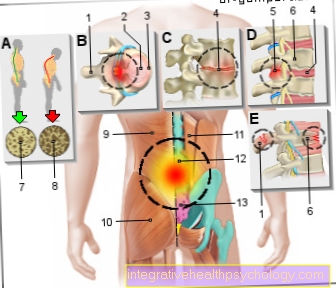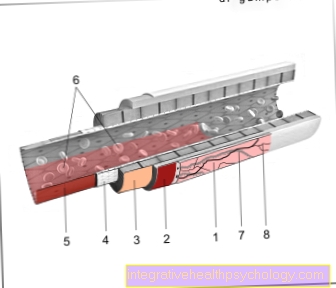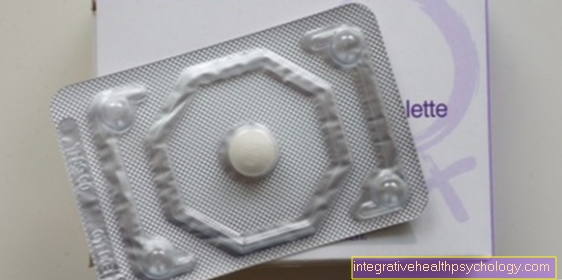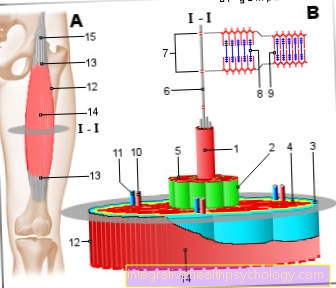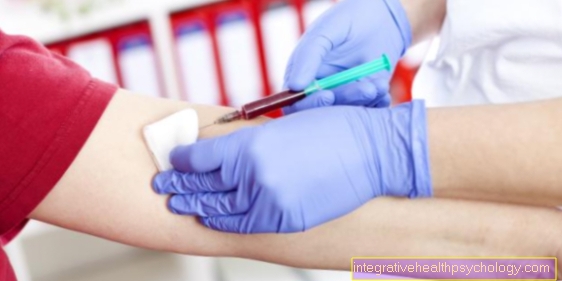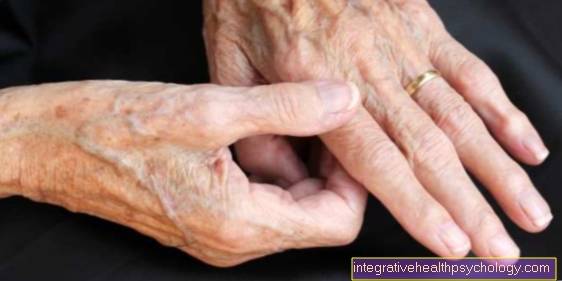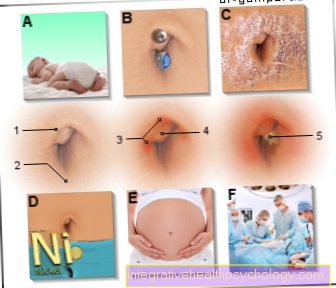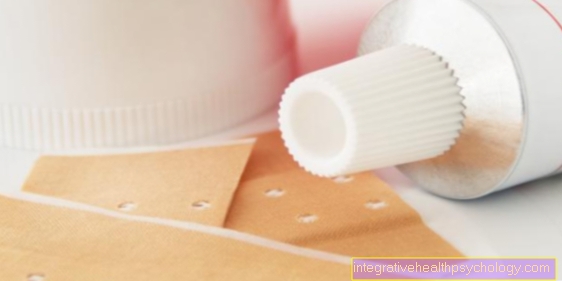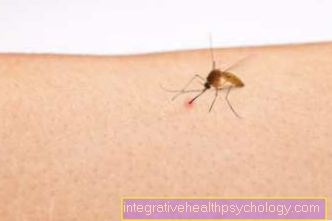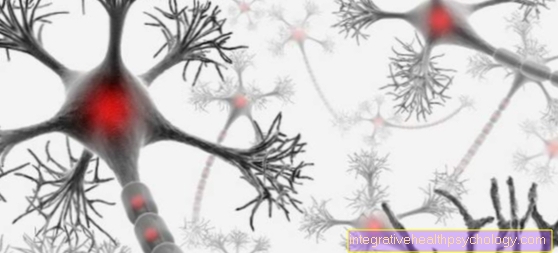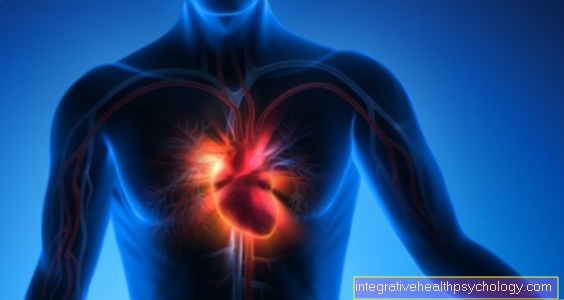How can you feel breast cancer?
introduction
Observing the breasts and palpating them regularly is an important part of the early detection of breast cancer. Every woman knows her body and breasts best and can therefore best determine changes in breast tissue for herself.
Scanning is quick and easy to learn. Essentially, the breasts are first visually examined for abnormalities and then scanned while standing and lying down.
Please note that self-scanning of the breasts in no way replaces a regular early diagnosis examination at the gynecologist.

Step-by-step instructions for breast palpation
The following text explains the procedure for a breast self-examination step by step.
Step 1
Stand in front of a mirror and make sure that there is sufficient lighting so that you can also notice small changes or abnormalities on the breasts or nipples. Take enough time for the examination and make sure that the atmosphere is calm.
Let your arms hang down at your sides relaxed and look at your breasts. In particular, look for changes in shape or contours, asymmetry in the breasts, and changes in the nipple or skin on the breasts.
Typical signs of breast cancer can also be bulging or contraction of the skin (so-called "orange peel"), persistent reddening or peeling.
Read more about this under: Signs of breast cancer
step 2
Now raise your arms and continue with the optical inspection of your breasts. Pay special attention to whether the breasts behave differently when you raise your arms. Changes in the mammary gland are often only visible when the arms are raised. Now the breasts can slowly be felt for lumps, knobs or indurations.
step 3
For palpation, each breast is mentally divided into four parts and each of these four so-called quadrants is examined in detail. Scanning can be clockwise or counterclockwise.
Use your whole hand to palpate, laying it flat on your chest. The fingers are slowly moved against each other (as when playing the piano) and the entire chest is examined systematically.
The chest is slowly felt for any lumpy or rough changes. First feel the breast superficially and then apply more pressure in order to be able to feel the tissue in depth. Pay particular attention to the quadrant, which is in the upper outer quarter of the breast, as this is where malignant changes in the mammary gland are particularly common.
Lumps that are difficult to move against the overlying skin would indicate a malignant tumor.Pain felt during palpation is less likely to be caused by breast cancer and is more likely to result from benign cysts in the breast.
Many women are frightened the first time because the fabric feels very uneven and lumpy. However, this is quite normal, since the breast is a gland with a more or less high proportion of fat and connective tissue.
Young women with small breasts in particular often have extremely dense glandular tissue that feels very knotty. After the menopause, the breasts in many women become softer as the glandular tissue recedes and is replaced by fat.
In the event of an unusual finding in the self-examination, the doctor should be consulted in any case.
Step 4
Take the nipple between your thumb and forefinger and squeeze gently. Watery or bloody secretions and discharge from one or both nipples outside of breastfeeding indicate a change in the mammary gland and should definitely be clarified by a gynecologist (gynecologist).
Step 5
Then dedicate yourself to your armpits and feel them while standing with your arms hanging down. Pay particular attention to hardening or swollen lymph nodes. Altered lymph nodes in the armpit area can be an indication of a malignant change in the breast or they can be caused by an inflammation in the body.
You might also be interested in this topic: Symptoms of breast cancer
Step 6
Finally, all the previous steps are repeated while lying down. When lying down, the chest muscle can relax and you can feel any changes that are deeper in the chest.
Memorize the tactile findings well and get to know your body better.
If there are noticeable changes or lumps, a doctor should be consulted as soon as possible.
Read more about this under: Breast cancer screening
When should you palpate the chest?
The best time to scan yourself is about a week after your last menstrual period, as the breasts are soft and easy to scan. Due to the influence of hormones, the breasts become larger and more sensitive to pain before menstruation, so palpation during this period is uncomfortable and is not recommended.
How often should one palpate the chest?
It is recommended that women aged 30 and over scan themselves at least once a month. Regular self-examination is important for the early detection of breast cancer, but it does not replace the medical check-up at the gynecologist, which should also take place every year.
Illustration breast cancer
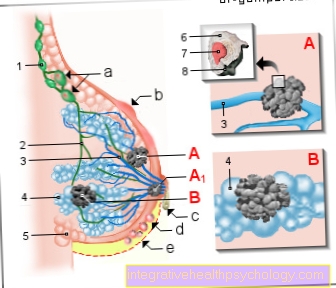
Breast Cancer - Breast Cancer
(Malignant tumor of the mammary gland)
- Axillary lymph nodes -
Nodi lymphoidei axillares - Lymph vessels -
Vasa lymphatica - Milk duct -
Lactiferous duct - Lobule of the mammary gland -
Lobuli glandulae mammariae - Adipose tissue -
Corpus adiposum mammae - Cancer cell -
Cell with altered genetic material
(Mutated cell) - Nuclear body -
Nucleus - Cell wall
Breast Cancer Symptoms:
a - Enlarged lymph nodes
b - lump in the chest
c - fluid leakage
from the nipple
d - skin dimples in the chest
e - change in color,
Size, shape of the chest
A - ductal carcinoma
(80%) - milk duct cancer, developed
located in the cells of the milk ducts
A1 - Paget's carcinoma -
a ductal carcinoma develops
especially in the nipple tissue
B - Lobular carcinoma
(15%) - lobular cancer,
arises in the mammary gland lobules
You can find an overview of all Dr-Gumpert images at: medical illustrations
What should be considered when palpating the chest?
It is important to note that no breasts are the same and that your own breast changes several times over the course of life.
The breast is a gland that is subject to fluctuations in hormones. This is why tissue changes occur within a menstrual cycle, during pregnancy and breastfeeding, during menopause and when taking the birth control pill. This should be kept in mind during the self-examination so as not to worry unnecessarily.
In addition, not every lump you can feel immediately means breast cancer. In young women in particular, these are mostly harmless changes, such as cysts or benign tumors of the mammary gland (Fibroadenomas).
Benign nodes can be recognized by the fact that they are clearly demarcated from the surrounding tissue and can easily be moved against the overlying skin.
Read more about this at: Benign breast tumors
Malignant tumors can only be felt from a certain size, in the best case a lump is only noticeable from one centimeter in size. This means that tumor diseases with clearly palpable nodules have already progressed further. Therefore, it is very important not to view self-examination as a substitute for medical breast cancer screening.
From the age of 30, the gynecologist examines the breasts annually for changes and from the age of 50 it is recommended to have a mammography screening every two years.
If there are abnormalities during the self-examination, this should be discussed and clarified with a gynecologist in any case, because the sooner breast cancer is diagnosed and treated, the better the chances of recovery. The self-examination can also be discussed with the gynecologist, who will help if anything is unclear.
You may also be interested in this topic: How to recognize breast cancer



